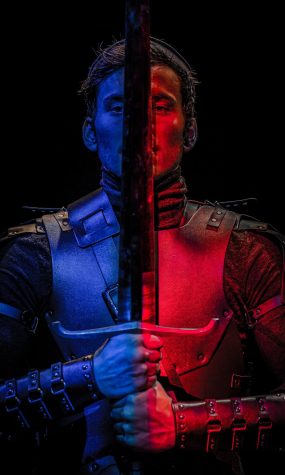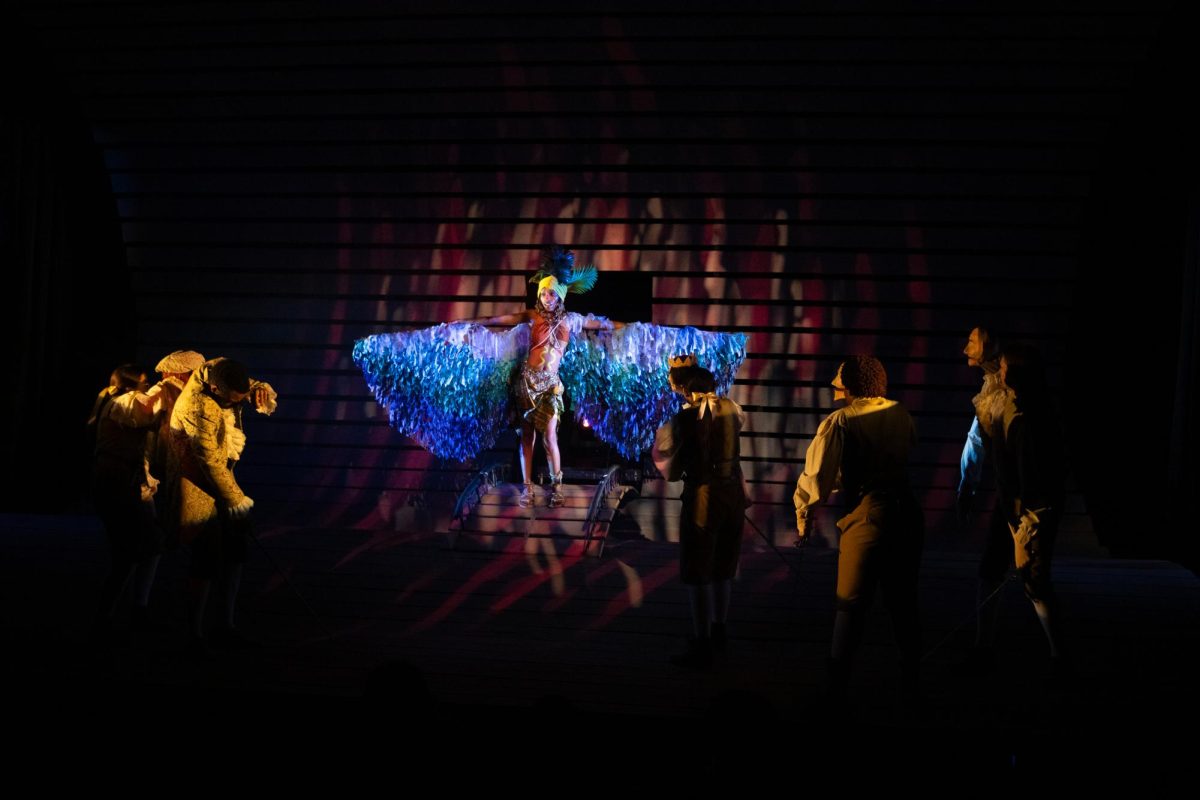Audiences at the University Theatre’s Production of ‘Macbeth’ are in for Several Surprises
Macbeth (Curtis Betourne) battles Macduff (Tahji McCombs) in the play’s climax.
November 16, 2022
Those who purchase a ticket for the University Theatre’s production of Shakespeare’s “Macbeth” may initially find themselves wondering if they’ve taken a wrong turn into a haunted house. After tickets are checked, ushers lead the theater-goers through a labyrinthine passage lined with billowing black paper, which opens into a dimly lit room where a sheet-covered human form lies upon a raised platform. This is just the first of several corpses audience members will face before the evening is over.
This brief but memorable maze ends in a surprisingly intimate performance area. There is no raised stage in front of straight rows of seats. Instead, seats are arranged in a tiered circle around the floor on which the actors perform. No matter where a viewer is seated, they will be treated to an excellent view of the tragedy unfolding before them.
As the audience trickles in, yet another human form covered in a bloody sheet lies deathly still in the center of the stage. Its morbid solemnity is hard to look away from. The spine-chilling atmosphere is accentuated by eerie background music and by four large projector screens positioned throughout the room that display live footage of theater-goers being led past the first corpse.
These screens prove to be one of the most exciting aspects of this particular production. In a creative multimedia approach, screens are employed throughout the play to display footage of the actors, adding to the depth and scope of the production. Without giving too much away, I can say that one of the most memorable examples was during the famous “Is this a dagger I see before me?” scene. In an interview with Joe Garvey of the ODU News Center, director Chris Hanna revealed that part of the reason for including the screens was to draw a connection with modern life; he said that in the play, “violence mostly occurs offstage. The audience views it on television screens, remotely, with increasing detachment.”

Not a single cast member dropped the ball; each gave a compelling and emotive performance that did the source material justice. I was especially impressed by Vania Alonnie as Lady Macbeth. Her interpretation of the character’s spiral from power-hungry murder accomplice to remorse-ridden wreck was fascinating to watch. Every cast member, from the main characters to the ensemble, deserves to feel proud of the work they have done.
Costume designer Meredith Magoun chose a dark color scheme for nearly every character, reflecting the themes of death and depravity present in the play. Interestingly, the traditional Scottish kilts were accentuated with glinting silver chains and grommets, giving them a punk-ish edge. This juxtaposition was a successful way of staying true to the original setting while adding a touch of modernity. This same spirit was reflected in the glitzy costuming of the three witches.
From spurting blood to a steaming cauldron, the practical effects were a joy to behold. The lighting, background music and sound effects pulled the audience further into this grisly tale of murder and betrayal.
When speaking with the ODU News Center, director Chris Hanna shared that he has “been waiting a lifetime for [the] chance [to direct “Macbeth”].” He also teased that audiences should be prepared for a “wild roller coaster ride.”
Anyone with the slightest interest in theater should put this production on their schedule. Even those who suffered through their Shakespeare class should consider giving this show a shot–they might be pleasantly surprised. “Macbeth” will be running through Nov. 20 at the Goode Theatre. Ticket information can be found here.









